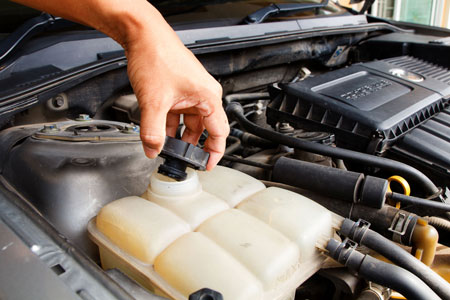
It’s fall and you’re in Southern California, so you might think you can put off any auto radiator and cooling system service until spring. But that’s not the case. The cooling system is the number one cause of breakdowns and the odds are you’ll have little warning before you suddenly have to pull off to the side of the road. That can happen any time of the year as a result of a leak, a failed water pump, or any of several other problems. With severe overheating you’ll even face major engine damage. So if you’ve been having to top off the coolant reservoir it’s time to have that looked into. If it’s been a year or two since you’ve had a cooling system inspection, drain, and flush then it’s probably time for that too.
Safety Note: The system operates under pressure and above the boiling point. So never open the radiator cap before your vehicle has cooled down. Otherwise you risk injury and scalding from flash steam.
Your Car’s Radiator & Engine Cooling System
Gasoline, diesel, or ethanol burning inside your engine creates temperatures hot enough to melt aluminum. It’s the engine cooling system’s job to remove heat from the engine. The water pump sends what’s actually a special coolant through channels in the engine block and out to the radiator which then dumps the heat into the outside air. Other parts include a reservoir for extra coolant, the radiator cap, a thermostat to control the flow of coolant, and various belts & hoses. Nowadays cars and light trucks also have an electric fan to increase airflow through the radiator when you’re stuck in traffic or idling. In some vehicles engine coolant also cools the transmission.
What’s that coolant? Around San Diego it’s a 50-50 mixture of pure water and antifreeze (propylene glycol) that reduces boil overs as well as protects against freezing. It also contains lubricants and anti-corrosion compounds.
Preventive Maintenance Radiator Service
Over time the anti-freeze degrades and becomes acidic, and the protective additives break down. So you need a periodic drain and fill, typically every 25-40,000 miles or every year or two. Always go by your owner’s manual. If you’ve misplaced it, we have that information direct from the manufacturer. A flush and fill additionally helps keep the radiator & engine cooling channels clear of scale and other build-ups. Scheduled maintenance also includes a careful inspection of the entire coolant system for leaks and other problems.
Problems and Radiator Repairs
If you’re having to add coolant to the reservoir or through the radiator cap, if there’s a puddle underneath, or if you notice a weird “maple syrup” smell then most likely you have a leak that should be looked in to right away. If your temperature gauge goes up into the read or fluctuates it’s also time for a mechanic’s troubleshooting. Other symptoms include a grinding sound from the water pump, rust or scale visible in the coolant, and water in the oil or transmission fluid.
Here are some of the most common cooling system and car radiator repairs, in no particular order.
- Replacing a failed thermostat. This is common enough that you may want to do this every few years anyway.
- Replacing a leaky hose. Likewise, hose replacements are a good idea after many years of service.
- Tightening or replacing a hose clamp.
- Bleeding air out of the coolant system.
- Replacing a failed water pump.
- Fixing a radiator leak or replacing the radiator.
Pacific Automotive San Diego
We’ve been pleasing customers with technical excellence and personalized service in San Diego for over 20 years. With ASE certified master mechanics we’re your affordable dealer alternative. Our work maintains your warranty, and we’ll keep you vehicle running great long after the warranty has expired. We’re ready for all of your auto repair services needs, and our radiator services include a comprehensive coolant system evaluation, flush and exchange service, and expert troubleshooting and repairs.
